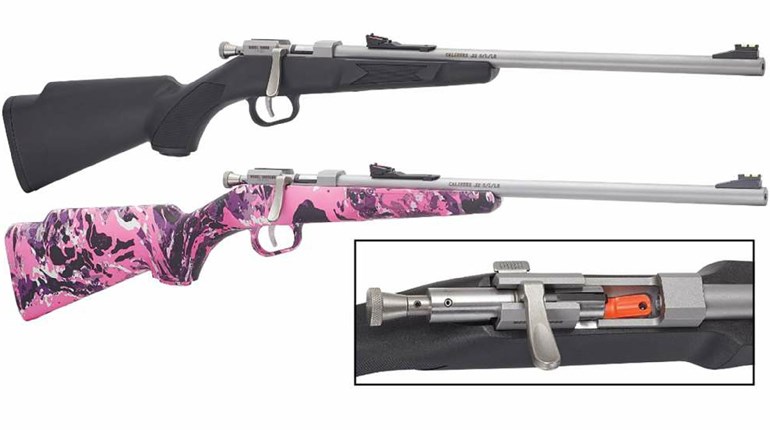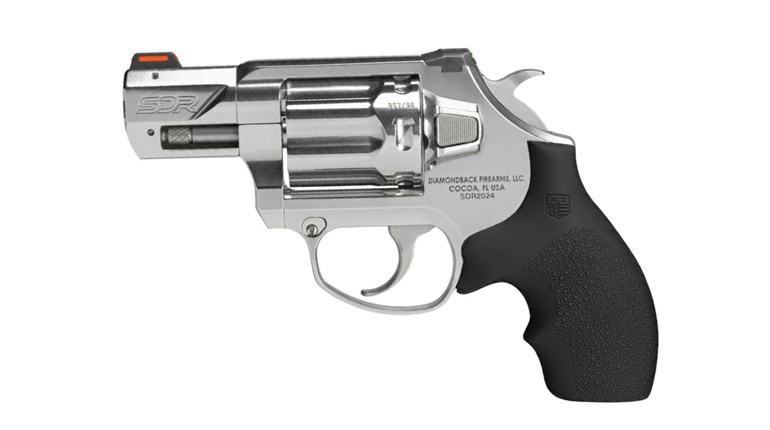
The Kimber KDS9c is something of a cross between a Model 1911 and a Glock, offering a 15-round capacity—with an 18-round magazine available.
The slide and barrel definitely show a 1911 lineage, but with improvements. The slide has a tri-top contour, and the cocking serrations on the front extend up and over the slide, so however you rack it, or do a press-check, you have purchase for your hand there.
The rear serrations also continue up and over, including on the optics-cut filler plate. If you stick with the iron sights, you have the serrations; if you replace the plate with an optic, you lose the extra serrations. The top of the slide is machined there for the RMSc/Holosun-K footprint (which is so much the standard that you might as well just say “ready for a red-dot”). The iron sights are tall enough to be seen though the bottom quarter or so of your optic, so you can do a zero check by aligning them.

The slide is contoured at the front with a slight bevel down from the muzzle area to make re-holstering a bit easier and smoother. The barrel is a beautiful bit of machinist’s artistry, with flutes along the sides of the barrel and the chamber. It also does not use a bushing; instead, the barrel flares to a cone, and the cone locks up in the bore of the slide on closing.
The barrel has an integral feed ramp, not the frame-and-barrel arrangement of the traditional 1911. Underneath the KDS9c’s barrel is a single-coil, flat-wire recoil spring on a guide rod and with a spring retainer.
Empty cartridges are extracted from the chamber by means of a large external extractor that pivots on a pin in the slide and is activated by a coil spring underneath the rear leg. The external hammer drives a firing pin in the same manner as the traditional 1911, which brings us to the big deal: the frame and its changes.
First, instead of polymer, Kimber elected to go with aluminum—in this case, 7075 alloy, the same as might be found in your AR-15. The frame is machined to accept high-capacity (compared to the 1911) magazines of Kimber’s design, holding 15 rounds of 9 mm each. You get two of them with the pistol. The frontstrap and mainspring housing, along with the G10 grips, are machined with a crosshatch pattern to provide a non-slip surface, so the KDS9c will likely not shift around much.

The frontstrap is undercut where it joins the trigger guard, so it’ll let your hand get as high on the frame as you can get it. At the rear, there is what looks like a grip safety, but it is not. It is the tang assembly. The tang allows, like the frontstrap, as high a grip as your hand can manage, and the aluminum frame and slim G10 grips keep the circumference small. Unlike the 1911, the KDS9c only uses one screw each to hold the grips on.
The sample KDS9c arrived in silver, with an anodized silver frame and stainless slide, but you can opt for an all-black version if you desire, and, just recently, Kimber unveiled a blued version with an accessory rail.
At the bottom of the frame, the frame and the mainspring housing extend below the clearance for the magazine baseplate, and this creates a backstop, or small shelf, that you can (and should) use as an index on reloading. On your reload, bring the magazine up to the magazine-well opening and strike the back of the feed lips against the shelf, before aligning the magazine to the frame and inserting it to lock. It doesn’t seem like much of an aid, but once you get the feel, it helps a great deal without adding much bulk.
 On the left side of the frame, we find the thumb safety, slide-stop lever and magazine-release button. The safety is slightly curved and long enough to get a good “bite” on it with your thumb. I shoot with my thumb riding the safety, so my thumb sometimes activates the slide-stop, keeping the slide from locking back. The KDS9c, while having a slightly lengthened slide-stop lever, isn’t long enough to cause me that problem. The magazine button is located where we expect it, and Kimber has taken the opportunity to make it somewhat egg-shaped, so those with shorter thumbs can still reach the rear edge.
On the left side of the frame, we find the thumb safety, slide-stop lever and magazine-release button. The safety is slightly curved and long enough to get a good “bite” on it with your thumb. I shoot with my thumb riding the safety, so my thumb sometimes activates the slide-stop, keeping the slide from locking back. The KDS9c, while having a slightly lengthened slide-stop lever, isn’t long enough to cause me that problem. The magazine button is located where we expect it, and Kimber has taken the opportunity to make it somewhat egg-shaped, so those with shorter thumbs can still reach the rear edge.
This KDS9c came with a left-side thumb safety, not an ambidextrous one, but it is machined for one. Kimber also now offers pre-installed left safeties.
And that brings us to the trigger. The KDS9c trigger is pure 1911 with a clean, crisp pull that breaks just below four pounds, so it was a joy to test. The trigger itself is medium-length, so with the slightly larger circumference, even those with average hands can comfortably reach the trigger. The hammer is a kinda-sorta “commander” hammer in that it has a rowel and is skeletonized, but it’s more angular than round, and that puts a serrated flat surface right on top where you can easily thumb-cock it. (Cocking the hammer reduces the amount of force needed to work the slide.)
In testing, the KDS9c proved to be accurate. The four-inch barrel takes a small bite out of the velocity of any 9 mm load, but not problematically.
The tight lockup and the recessed crown give the barrel a good leg up when it comes to potential accuracy. The trigger was a joy; the slide locked open after the last shot; and the magazines fell free of their own weight. In all, testing this Kimber was less work than play.
The KDS9c was accurate with all loads tested. Sometimes a firearm will show a preference, but this one did not. After bench testing, I cleaned out the odds-and-ends ammo bin of miscellaneous rounds, plinking on the club’s 100-yard rifle gong, a one-foot-square plate. If I occasionally missed, it was because of me, not the Kimber.
So, what is the place of the Kimber KDS9c? It’s an example of the best of all worlds. It has the capacity of the various polymer-framed 9 mm pistols filling gun-shop counters. But along with that, it has the trigger of a 1911, without the sometimes eye-watering price a semi-custom or custom high-capacity 9 mm 1911 commands. It is one to two thousand dollars less than metal/polymer and other 1911 descendants, and that price differential buys you a lot of practice ammo and range time.
If, at the end of the day, all you want is an accurate, soft-shooting 9 mm pistol, then the KDS9c has just what you need.

































